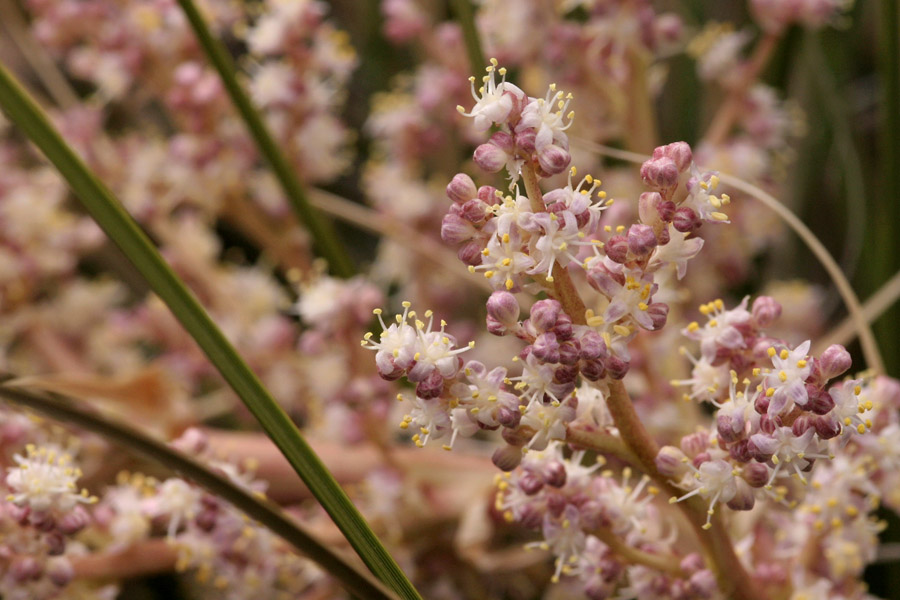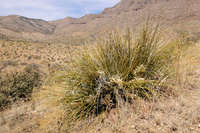|
|
|
|
Family: Asparagaceae
Texas sacahuista
[Nolina affinis Trel., moreNolina texana var. compacta (Trel.) I.M.Johnst.] |
Plants acaulescent, cespitose; rosettes from vertical, subterranean branched caudices. Leaf blades wiry, stiff, triangular, slightly concavo-convex toward base, 40-90 cm × 2-4(-7) mm, not glaucous; margins entire, rarely remotely serrate with widely separated, noncartilaginous teeth, tips dying; inflorescence leaf blades curling distally, 10-50 cm. Scape curling distally, 0.5-2 dm. Inflorescences paniculate, rarely purple, 2.5-7 dm × 5-17 cm, held completely or partially within rosettes; main rachis and divisions thick, rigid, lateral branches ascending; bracts persistent, to 10-40 cm; bractlets laciniate, 1-2 mm. Flowers: tepals yellow-green, 2.5-3.5 mm; fertile stamens: filaments 0.9-1.4 mm, anthers 0.8-1 mm; infertile stamens: filaments 0.6-0.8 mm, anthers 0.4-0.5 mm; fruiting pedicel ascending, thick, articulate near base, noticeably dilated into perianth, proximal to joint 2.5-6 mm, distal to joint 1.5-2 mm. Capsules thin-walled, inflated, 3-4 × 4.5-5.5(-8) mm. Seeds closely invested in capsules, rounded, bursting ovary walls, 2.6-3.4 mm diam. 2n = 38. Flowering late winter--early spring. Rocky hillsides, limestone, granite, grasslands, shrublands; 200--2000 m; N.Mex., Tex.; n Mexico. Nolina texana is centered primarily on the Edwards Plateau west through the trans-Pecos region of Texas. Nolina texana var. compacta is not recognized as distinct from var. texana. They have the same distributions. Variety compacta has compact inflorescences with functionally pistillate flowers, which is typical of the functionally pistillate plants of var. texana. Those plants with elongate secondary branches have functionally staminate flowers and are characteristic of both varieties. The dark, round seeds are quite distinct in the open fruit chambers on inflorescences hidden within the basal leaves. Some plants from the high plains of eastern New Mexico, northwestern Oklahoma, and southern Colorado were considered to be N. texana (see 7. N. greenei). Further study of these populations may help determine if they truly are a part of this complex.
FNA 2003, USDA Plants Common Name: Texas sacahuista Duration: Perennial Nativity: Native Lifeform: Subshrub General: Acaulescent rosette, growing in dense clumps, with the appearance of a large coarse grass. Leaves: Blades curling at the tips, 40-90 cm long and 2-4 mm wide, triangular, margins entire and rarely serrate with widely separated teeth. Flowers: Flowering stalk curling towards the tip, infloresences yellow-green, rarely purple, not exceeding or only partially contained within the rosettes, bracts persistent. Flower tepals 2.5-3.5 mm, fertile stamens to 1.5 mm. Fruits: Capsules borne on a thick, ascending pedicel, capsules thin-walled and inflated, to 5.5 mm. Seeds rounded. Ecology: Found on limestone or granitic substrates on rocky hillsides, grasslands and shrublands, from 500-6,500 ft (152-1981 m); flowers late winter-early spring. Distribution: s AZ, s CO, NM, s TX, w OK; south to n MEX. Notes: Distinguished from N. microcarpa by having a shorter inflorescence which doesn-t surpass the leaves and leaves with sparse to no teeth on the margins. Ethnobotany: Specific use of species is unknown, however the genus was used to make baskets, mats and cradles, and the crowns and bases of leaves were pounded together to make soap by the Apache. Etymology: Nolina is named for Abbe Pierre Charles Nolin (b. 1717) a French arboriculturalist, while texana means of or from, or somehow relating to, Texas. Synonyms: Nolina affinis, Nolina texana var. compacta Editor: LCrumbacher 2011, FSCoburn 2015 |
|
|
|



